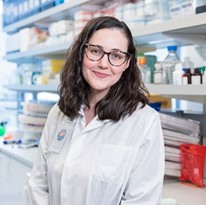Modeling secondary hemophagocytic lymphohistiocytosis (HLH): An innate immune primary story
Heather Gustafson, Ph.D.
Assistant Professor of Pediatrics, University of Washington & Seattle Children’s Hospital
Friday, April 12th at 11:45 am
In-Person in SMBB 2650
Heather Gustafson, PhD is an Assistant Professor in the Department of Pediatrics, Division of Hematology/Oncology at the University
of Washington, and a Principal Investigator at Seattle Children’s Research Institute. She received a BSE in Biomedical Engineering from
Case Western Reserve University and a PhD in Bioengineering from the University of Utah. Her postdoctoral fellowship was joint between
the University of Washington and Walter and Eliza Hall Medical Institute in Melbourne, Australia. Dr. Gustafson joined the faculty of SCH
in the fall of 2019, her research program focuses on training a child’s own immune system to eliminate cancer. We believe the key to
doing this is through first understanding where the crucial dysregulation or untrained points are in that child’s innate immune system,
then using that information to “re-train” the innate immune system to clear cancer. More information can be found at http://editlabs.org
Abstract: Our lab hypothesizes that a child’s specific innate immune characteristics prior to cancer therapy can predict clinical outcomes
(efficacy and toxicity). It has often been thought that disease characteristics are the primary driver of host immune response. Our lab
proposes that exposure to immune modulatory life events and resulting variations (infection, microbiome, vaccination, gene mutations,
etc.) establishes a child’s inflammatory baseline, impacting disease progression and response to therapy. Our work takes inspiration from
the pathophysiological overlap between toxicities resulting from immunotherapeutics and hemophagocytic lymphohistiocytosis (HLH).
HLH is often triggered by autoimmune diseases, malignancy, or infection. It is characterized by defective lymphocyte cytotoxicity, with
increased cytokine production, coupled with uncontrolled myeloid activation. Importantly while this disorder is known to be induced by
specific genetic mutations associated with inflammation, anyone can develop the disorder, suggesting that life history can imprint
susceptibility.
Secondary HLH is known to drastically reduce 5-year survival in malignancies. This is consistent with reduced overall survival in patients
who developed secondary HLH during immunotherapy (e.g. Chimeric Antigen Receptor or CAR-T patients). It is known that T cells in HLH
patients are continuously activated by antigen/tumor, yet lack the capacity to fully clear the disease. Thus, we hypothesize that the HLH
axis may drive post-CAR-T toxicity, as well as poor overall therapeutic efficacy. Further, this dichotomic axis may drive and be broadly
applied to other cancer treatments where HLH can present as an undesirable toxicity and which license T cell or NK cell behavior to resolve
tumorigenesis (e.g. transplant, bispecific antibodies, checkpoint blockade and chemotherapeutic regimes). We hypothesize that a basal
level of cytokine secretion from myeloid populations is necessary for overall therapeutic benefit, but highly amplified cytokine responses
can induce toxicity or result in non-responsiveness, due to dramatic upregulation of negative feedback mechanisms downstream of
toxicity outcomes. Further, we hypothesize that levels of cytokine secretion can be predicted by the inflammatory status of a patient prior
to therapy, which could then be used clinically to help inform interventional strategies.
